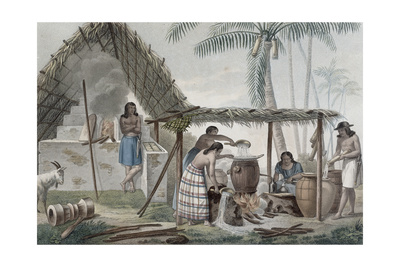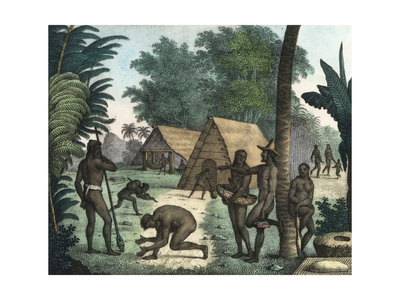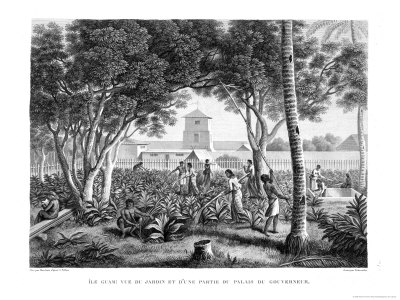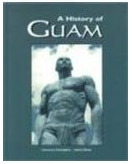Guam
International Harbors
The original inhabitants of Guam are believed to have been of Indo-Malaya descent originating from Southeast Asia as early as 2,000 B.C., and having linguistic and cultural similarities to Malaysia, Indonesia and the Philippines. The Chamorro flourished as an advanced fishing, horticultural, and hunting society. They were expert seamen and skilled craftsmen familiar with intricate weaving and detailed pottery making who built unique houses and canoes suited to this region of the world. The Chamorro possessed a strong matriarchal society and it was through the power and prestige of the women, and the failure of the Spanish overlords to recognize this fact, that much of the Chamorro culture, including the language, music, dance, and traditions have survived to this day.
The Spanish Era (1565 - 1898)
 |
| View of a Distillery on the Island of Guam Alphonse Pellion |
The first known contact between Guam and the West occurred when Ferdinand Magellan anchored his small 3-ship fleet in Umatac Bay on March 6, 1521. Hungry and weakened from their long voyage, the crew hastily prepared to go ashore and restore provisions.
However, the excited native Chamorro's, who did not share the Spaniards concept of ownership, canoed out first and began helping themselves to everything that was not nailed down. The weakened sailors had trouble fending off the tall and robust natives until a few shots from the Trinidad's big guns frightened them off the ship and they retreated into the surrounding jungle. Magellan was eventually able to obtain rations and offered iron, a commodity highly prized by Neolithic peoples, in exchange for fresh fruits, vegetables and water.
 |
| Chamorro People of the Island of Guam |
Details of Magellan's visit, and the first known Western documentation of Guam and the Chamorro, come from the journal of Antonio Pigafetta, Magellan's chronicler and one of only 18 original crew members to survive Ferdinand Magellan's ill-fated circumnavigation of the globe.
Guam and the other Mariana Islands were formally claimed by the Spanish Crown in 1565 by Miguel Lopez de Legazpi. In 1668, Jesuit missionaries led by Padre Diego Luis de San Vitores, arrived on Guam to establish their brand of European civilization, Christianity and trade. The Spanish taught the Chamorro's to cultivate maize (corn), raise introduced cattle and tan hides, as well as to adopt western-style clothing. Once Christianity was firmly established, the Catholic Church became the focal point for village activities and Guam became a regular port-of-call for the Spanish treasure galleons that crisscrossed the Pacific Ocean from Mexico to the Philippines.
During the 18th century, the Spanish Galleons were preyed upon by English pirates who visited Guam to take on supplies and provisions. The Galleon Era ended in 1815 following the Mexican Revolution. Guam was host to a number of scientists, voyagers, and whalers from Russia, France and England some of whom provided detailed accounts of the daily life on Guam under Spanish rule.
December 31, 1898, San Francisco Call, > San Francisco, California, U.S.A.
NATIVES HAVE RETAKEN GUAM
They Have Also Massacred the Spanish Garrison at Ponapi, Caroline Islands.
MANILA, December 30. The British schooner Esmeralda, which has just arrived here from the Ladrone Islands, reports that after the United States cruiser Charleston left the island of Guam, in June last, the Spaniards refused to recognize the authority of Francis Portusach, who was verbally appointed by Captain Glass to continue his former regime as Governor, and Jose Sisto, a former public administrator, was declared Governor. He armed part of the native guards, collected a tax of $6 a head and had secreted fifteen tons of powder and a small stock of ammunition when the island was taken by the Americans.
The schooner Albi reports the massacre of the Spanish garrison by the combined native forces at Ponapi, Caroline Islands. Henry Neoti, an educated chief, has been selected to be the ruler. He is said to be favorable to Americans.
WASHINGTON, Dec. 30. Secretary Long has Issued an order to Captain Louis Kempff at Mare Island to proceed to Guam and take possession of the island. It is understood that Captain Kempff will go to Hawaii and to Guam on the Philadelphia or Bennlngton. Captain Kempff is one of the highest ranking officers of the service, and has been stationed on the Pacific Coast for a number of years. He is now at Mare Island. He is familiar with the Ladrones, as he formerly served with the Asiatic squadron.
Francis Portusach, whom the officers of the United States cruiser Charleston left in charge of Guam, he being the only American citizen there, is a native of Spain, where he was born about thirty years ago. He took out his citizenship papers in Chicago during the year 1888. He is said to be the son of a wealthy merchant of Barcelona.
Guam was ceded to the United States by the Treaty of Paris ended the Spanish American War in 1898 and formally purchased from Spain for $20 million in 1899. At the time of the turnover, the local population of Guamhas grown to about 10,000 inhabitants. U.S. President William McKinley issued an executive order placing Guam within the administration of the Department of Navy. CAPT R. P. Leary was appointed the island's first U.S. Governor. Under Navy administration, Guam experienced many improvements in the areas of agriculture, public health, sanitation, education, land management, taxes, and public works.
 Medieval Sailors mistake a Sleeping Whale for an island; disembark in order to cook their lunch. |
January 1, 1899, San Francisco Call, San Francisco, California, U.S.A.
NO NEWS OF RIOTS RECEIVED FROM DEWEY
NEW YORK, December 31. A Washington special to the Herald says: No official word has been received from Admiral Dewey confirmatory, of the reports that riots have occurred on Guam Island, and that Spaniards are again in control. It is expected that news will soon be received concerning the situation, as the collier Brutus sailed from Manila to Guam December 19, and should have arrived before Christmas. She will remain until the arrival of the Bennington, which will start for Guam probably the last of next Week, stopping on the way to hoist the American flag over Wake Island.
The auxiliary cruiser Yosemite, which will, be the station ship for Guam, will be pushed and is expected to start for the east about the middle of January. She will carry about 400 men for Dewey's command.
Captain Louis Kempff, formerly commander of the Monterey, who has been selected as the naval commander of Guam Island, will be under the control of the navy and will net be subordinate to Major General Otis. With a view to the establishment of order in Guam, as in other new possessions of this Government, steps have been taken by the Navy Department to expedite, the construction of the naval station there.
Secretary Long appointed a board several days ago to consider the needs of the proposed naval station. Contracts were made today in New York for materials for coal sheds, which will accommodate 10,000 tons of coal, a pier, storehouse, quarters for officers and barracks for marines. These buildings and pier will be built in sections, so they can be readily set up. The coaling station will be on the shore of the Bay of San Luis de Apra.
February 21, 1899, Los Angeles Herald, Los Angeles, California, U.S.A.
The Guam Colony
SACRAMENTO, February 20. It is stated that a number of young men of this city are preparing to go to the island of Guam and there engage in raising the staple products of the island. One who claims to be interested in the proponed colony says they are to incorporate, purchase the bark Ruth and go in a body.
March 14, 1899, San Francisco Call, San Francisco, California, U.S.A.
WITH SUPPLIES FOR THE STATION AT GUAM
WASHINGTON, March 13. The Navy Department is informed by Admiral Dewey that the supply ship Nanshan has left Manila with supplies for the new naval station at Guam.
March 25, 1899, San Francisco Call, San Francisco, California, U.S.A.
Missionaries to Guam.
HONOLULU, March 18. The little twenty-two ton schooner Bessie B. Stevens got away, for Guam on the 11th. She cleared for Manila via Guam. She carried twelve persons besides her crew. Three of these go as missionaries to Guam. They are Jose Castino and Jose Castino, Jr., and Edward Supery. The others are Douglas Bell, a surveyor, and his wife, Jared D. Rumherg and wife and James Rumberg, tourists; Allen Johnson, a sailor, and Benjamin Havner, the owner of the schooner, his wife and daughter.
May 6, 1899, Los Angeles Herald, Los Angeles, California, U.S.A.
WILL GOVERN GUAM
Captain Leary to Sail From New York Today
NEW York, May 5. Naval Constructor Richard P. Leary of the island of Guam will sail at 1 oclock tomorrow on the Yosemite for his Pacific ocean station. Captain Leary said today:
"All my orders have been published. We have been sent out to govern Guam, and we are going to do it."
The Yosemite carried an assorted cargo. There is a canal boat stowed in the hold, stoves, ranges, bicycles and goods enough to stock a country store. The 125 marines are under command of Major A. C. Kelter. They have a band of ten pieces. The voyage will be made by way of the Suez canal. Captain Leary will also be postmaster general of Guam. He carries all the paraphernalia of a postal station. Guam is to be made a naval station. Barracks for 500 marines will be erected. ~ Associated Press.
May 12, 1899, Los Angeles Herald, Los Angeles, California, U.S.A.
Bound for Guam
New York, May 11 -- The United States auxiliary cruise Yosemite, bound for Guam, passed Sandy Hood bout out at 6:28 a.m. today. The Yosemite carries Captain Richard P. Leary, the newly appointed Governor of Guam, and a garrison of marines for Guam, together with a quanity of stores and supplies. ~ Associated Press
Captured by the Japanese in 1941, it was retaken by the US three years later. The military installation on the island is one of the most strategically important US bases in the Pacific.
1899. World's Fleet. Boston Daily Globe
Lloyds Register of Shipping gives the entire fleet of the world as 28,180 steamers and sailing vessels, with a total tonnage of 27,673,628, of which 39 perent are British.
| Great Britain | 10,990 vessels, total tonnage of 10,792,714 |
| United States | 3,010 vessels, total tonnage of 2,405,887 |
| Norway | 2,528 vessels, tonnage of 1,604,230 |
| Germany | 1,676 vessels, with a tonnage of 2,453,334, in which are included her particularly large ships. |
| Sweden | 1,408 vessels with a tonnage of 643, 527 |
| Italy | 1,150 vessels |
| France | 1,182 vessels |
For Historical Comparison
Top 10 Maritime Nations Ranked by Value (2017)
| Country | # of Vessels | Gross Tonnage (m) |
Total Value (USDbn) |
|
|---|---|---|---|---|
| 1 | Greece | 4,453 | 206.47 | $88.0 |
| 2 | Japan | 4,317 | 150.26 | $79.8 |
| 3 | China | 4,938 | 159.71 | $71.7 |
| 4 | USA | 2,399 | 55.92 | $46.5 |
| 5 | Singapore | 2,662 | 64.03 | $41.7 |
| 6 | Norway | 1,668 | 39.68 | $41.1 |
| 7 | Germany | 2,923 | 81.17 | $30.3 |
| 8 | UK | 883 | 28.78 | $24.3 |
| 9 | Denmark | 1,040 | 36.17 | $23.4 |
| 10 | South Korea | 1,484 | 49.88 | $20.1 |
| Total | 26,767 | 87.21 | $466.9 | |









 Copyright ~ 1998-2018.
Copyright ~ 1998-2018. 